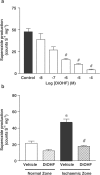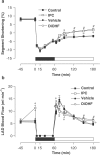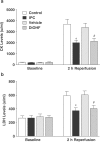3',4'-Dihydroxyflavonol reduces infarct size and injury associated with myocardial ischaemia and reperfusion in sheep
- PMID: 15148246
- PMCID: PMC1574976
- DOI: 10.1038/sj.bjp.0705815
3',4'-Dihydroxyflavonol reduces infarct size and injury associated with myocardial ischaemia and reperfusion in sheep
Abstract
1 The antioxidant properties of flavonols in vivo and their potential benefits in myocardial ischaemia/reperfusion (I/R) injury have been little investigated. We evaluated the ability of a synthetic flavonol, 3',4'-dihydroxyflavonol (DiOHF) to scavenge superoxide in post-I/R myocardium and to prevent myocardial I/R injury. 2 Anaesthetized sheep were studied in four groups (n=5-6): control, ischaemic preconditioning (IPC), vehicle and DiOHF (before reperfusion, 5 mg kg(-1), i.v.). The left anterior descending coronary artery was occluded distal to the second diagonal branch for 1 h followed by 2 h of reperfusion. Infarct size, myocardial function, NADPH-activated superoxide generation and biochemical markers of injury were measured. 3 DiOHF (10(-8)-10(-4) m) incubated in vitro with post-I/R myocardium from the vehicle group suppressed superoxide production dose-dependently. 4 DiOHF administered in vivo also significantly reduced superoxide generation in vitro. DiOHF and IPC markedly reduced infarct size, which was 73+/-2% of the area at risk in vehicle, 50+/-4% in DiOHF, 75+/-5% in control and 44+/-4% in IPC. Post-I/R segment shortening within the ischaemic zone was greater in DiOHF (2.3+/-0.7%; P<0.01) and IPC (1.7+/-0.5%; P<0.01) than those in corresponding controls (-1.7+/-0.4; -2.1+/-0.4%). 5 DiOHF and IPC improved coronary blood flow to the ischaemic area and preserved higher levels of nitric oxide metabolites in the venous outflow from the ischaemic zone. 6 DiOHF attenuated superoxide production in post-I/R myocardium, and significantly reduced infarct size and injury following I/R in anaesthetized sheep. The extent of protection by DiOHF is comparable to that afforded by IPC. Thus, DiOHF has clinical potential for improving recovery from acute myocardial infarction and other ischaemic syndromes.
Figures






Similar articles
-
3',4'-Dihydroxyflavonol improves post-ischaemic coronary endothelial function following 7days reperfusion in sheep.Eur J Pharmacol. 2009 Dec 10;624(1-3):31-7. doi: 10.1016/j.ejphar.2009.10.001. Epub 2009 Oct 13. Eur J Pharmacol. 2009. PMID: 19825372
-
Myocardial protection with postconditioning is not enhanced by ischemic preconditioning.Ann Thorac Surg. 2004 Sep;78(3):961-9; discussion 969. doi: 10.1016/j.athoracsur.2004.03.033. Ann Thorac Surg. 2004. PMID: 15337028
-
Antioxidant activity contributes to flavonol cardioprotection during reperfusion of rat hearts.Free Radic Biol Med. 2011 Oct 1;51(7):1437-44. doi: 10.1016/j.freeradbiomed.2011.07.003. Epub 2011 Jul 18. Free Radic Biol Med. 2011. PMID: 21801832
-
Signalling pathways in ischaemic postconditioning.Thromb Haemost. 2009 Apr;101(4):626-34. Thromb Haemost. 2009. PMID: 19350104 Review.
-
[Ischemic postconditioning: an effective strategy of myocardial protection?].G Ital Cardiol (Rome). 2006 Jul;7(7):464-73. G Ital Cardiol (Rome). 2006. PMID: 16977786 Review. Italian.
Cited by
-
DiOHF Protects Against Doxorubicin-Induced Cardiotoxicity Through ERK1 Signaling Pathway.Front Pharmacol. 2019 Sep 27;10:1081. doi: 10.3389/fphar.2019.01081. eCollection 2019. Front Pharmacol. 2019. PMID: 31611788 Free PMC article.
-
3',4'-dihydroxyflavonol ameliorates endoplasmic reticulum stress-induced apoptosis and endothelial dysfunction in mice.Sci Rep. 2018 Jan 29;8(1):1818. doi: 10.1038/s41598-018-19584-8. Sci Rep. 2018. PMID: 29379034 Free PMC article.
-
Effects of Polyphenols on Oxidative Stress-Mediated Injury in Cardiomyocytes.Nutrients. 2017 May 20;9(5):523. doi: 10.3390/nu9050523. Nutrients. 2017. PMID: 28531112 Free PMC article. Review.
-
Thinking Outside the Therapeutic Box: The Potential of Polyphenols in Preventing Chemotherapy-Induced Endothelial Dysfunction.Cells. 2025 Apr 9;14(8):566. doi: 10.3390/cells14080566. Cells. 2025. PMID: 40277892 Free PMC article. Review.
-
Cardioprotective activity of chalcones in ischemia/reperfusion-induced myocardial infarction in albino rats.Exp Clin Cardiol. 2012 Sep;17(3):110-4. Exp Clin Cardiol. 2012. PMID: 23620697 Free PMC article.
References
-
- AMBROSIO G., BECKER L.C., HUTCHINS G.M., WEISMAN H.F., WEISFELDT M.L. Reduction in experimental infarct size by recombinant human superoxide dismutase: insights into the pathophysiology of reperfusion injury. Circulation. 1986;74:1424–1433. - PubMed
-
- AMBROSIO G., TRITTO I. Reperfusion injury: experimental evidence and clinical implications. Am. Heart. J. 1999;138:S69–S75. - PubMed
-
- AMBROSIO G., WEISMAN H.F., MANNISI J.A., BECKER L.C. Progressive impairment of regional myocardial perfusion after initial restoration of postischemic blood flow. Circulation. 1989;80:1846–1861. - PubMed
-
- AUCHAMPACH J.A., MARUYAMA M., CAVERO I., GROSS D.J. The new K+ channel opener Aprikalim (RP 52891) reduces experimental infarct size in dogs in the absence of hemodynamic changes. J. Pharmacol. Exp. Ther. 1991;259:961–967. - PubMed
-
- BAYRAKTUTAN U., BLAYNEY L., SHAH A.M. Molecular characterization and localization of the NAD(P)H oxidase components gp91-phox and p22-phox in endothelial cells. Arterioscler. Thromb. Vasc. Biol. 2000;20:1903–1911. - PubMed
Publication types
MeSH terms
Substances
LinkOut - more resources
Full Text Sources
Other Literature Sources
Medical

